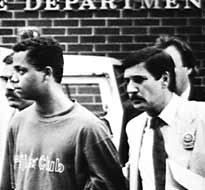 |
HIGH CRIMES: Rape and murder suspect Matias Reyes is taken by detectives for booking.
(Photo: The Daily News) |
He wiped her blood off his hands and went home. Left behind, in a shallow ravine near Central Park's 102nd Street transverse, was the brutalized body of a 28-year-old woman. Matias Reyes says he had raped and beaten her so viciously that he assumed she would die. The curly-haired 17-year-old boy calmly strolled north, into the night.
Thirteen years later, Reyes returns to the scene of the crime. This time he is in handcuffs, after a six-hour drive from the cell in a state prison near the Canadian border where he's serving 331⁄3 to life after pleading guilty, in 1991, to four rapes and the murder of a pregnant woman. For this visit to the 102nd Street transverse, on a spring day in 2002, Reyes is accompanied by investigators from the Manhattan district attorney's office. They want to test the claim that Reyes waited until this year to make: that on the night of April 19, 1989, he and he alone attacked the woman who became known around the world as the Central Park jogger.
His first appearance at this spot triggered events that nearly consumed the city. Now the return of Matias Reyes is roiling dozens of lives all over again.
Five teenagers were convicted of the attack on the Central Park jogger, in two stormy trials. All pleaded not guilty and claimed that their videotaped confessions were concocted by the cops. Antron McCray, Kevin Richardson, Raymond Santana, Yusef Salaam, and Kharey Wise served sentences ranging from five to thirteen years. Wise got out of prison August 12 -- just months after the only DNA collected at the crime scene, which was never tied to any of the accused, was matched to Reyes.
In August, lawyers for the five petitioned to have the convictions dismissed, saying that new evidence -- Reyes's confession and his DNA -- had surfaced that could have substantially altered the original verdicts. The D.A.'s office has been reinvestigating the Central Park case for nine months -- but on October 21, Robert Morgenthau's office will be back in State Supreme Court asking for a 30-day extension. Reyes has now been linked to eight rapes in a seven-month period, including one in Central Park on April 17, two days before the infamous jogger attack.
No matter what Judge Charles Tejada ultimately decides, the case has already had multiple, dramatic consequences: most tragically for the jogger, who nearly died. After years of rehabilitation, she still suffers from impaired vision and sketchy balance. Her emotional trauma is unquantifiable. And five anguished families watched their sons disappear into prison.
The case also changed the city itself. Bigger trends -- the crack plague, the economic bust and then boom -- played dominant roles in the story of the nineties. But the symbolism of the Central Park case altered everything from two mayoral elections to the reaction when a knot of teenage boys appeared on a dimly-lit sidewalk.
Now the case returns, uncannily, as anxieties about crime, civil rights, and the economy revive -- and as part of a revolution sweeping the criminal-justice system, courtesy of DNA testing and a new concern about false confessions.
New York in the spring of 1989 was a city of jangling nerves and rising fears. Crack was blighting whole families and neighborhoods. Violent-crime rates were rising for the third straight year, and homicides would set a record. On Wall Street, the mergers-and-acquisitions bubble was giving way to corporate scandals. A new buzzword, underclass, was emerging as the label for the seemingly intractable urban pathology spawned by poverty.
Race relations framed many of the media's big stories. The Reverend Al Sharpton was still loudly proclaiming that Tawana Brawley told the truth. Three white men convicted of chasing a 23-year-old black man, Michael Griffith, to his death on the Belt Parkway were beginning a contentious appeal.
And 1989 was a mayoral-election year. Ed Koch's shrillness was a central issue in a tight Democratic-primary campaign. His strongest rival, Manhattan borough president David Dinkins, was, not coincidentally, a black man with an anodyne personality. Racial tensions worsened in August, when 16-year-old Yusef Hawkins, a black kid lost in Bensonhurst, was attacked by racist white thugs, shot, and killed.
Beneath these volatile events churned the Central Park jogger case. The victim was white and middle-class and female, a promising young investment banker at Salomon Brothers with a Wellesley–Yale–Phi Beta Kappa pedigree. The suspects were black and Latino and male and much younger, some with dubious school records, some from fractured homes, all from Harlem. That the crime took place in Central Park, mythologized as the city's verdant, democratic refuge, played right into the theme of middle-class violation.
Almost from the moment the jogger was found, the Central Park case has existed as a vehicle for clashing worldviews: that held by the older, white, traditional-family-structure New York and that of the newer, nonwhite, poorer, marginalized New York. The furious reaction to the arrests and the trials illustrated how stark that cultural divide had become. And though the current legal breakthrough in the jogger case comes from the advent of cold, scientific DNA testing, the war for perceptions remains trapped in opposing views of the police: faith or mistrust.